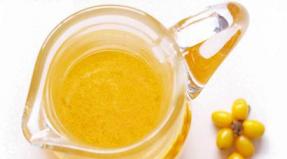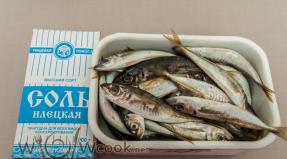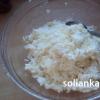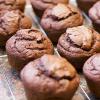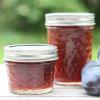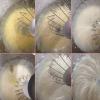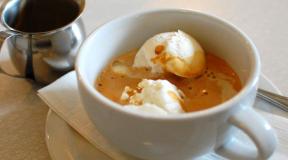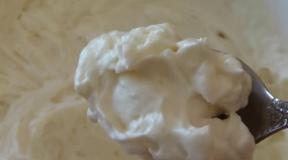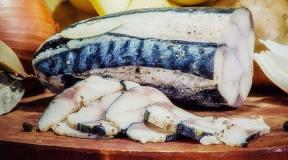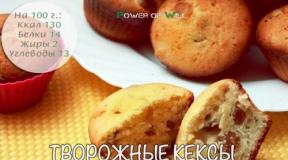Napoleon made from cornmeal. Napoleon cake with custard
- For cakes:
- Eggs - 3 pcs.
- Sugar - 200 g.
- Cottage cheese - 250 g.
- Flour - 350 g.
- A pinch of salt.
- Soda, quenched with vinegar - 1 teaspoon
- For the cream:
- Milk - 1 liter.
- Eggs - 4 pcs.
- Sugar - 200 g.
- Flour - 3 tablespoons (better than corn).
- Butter - 400 g.
- Soft cottage cheese - 200 g.
Cooking method
- Step 1 Beat eggs and sugar until firm foam. For a better lather, add a pinch of salt.
- Step 2 Rub the cottage cheese through a sieve or grind in a blender into a homogeneous mass.
- Step 3 Add cottage cheese to the beaten eggs and beat again.
- Step 4 Add soda, quenched with vinegar and wheat flour, knead the dough. The dough should be soft, but not creep.
- Step 5 Divide the dough into pieces according to the number of cakes and refrigerate for 30 minutes to cool. If your form has a diameter of 22 cm, then you will get 7-8 cakes from this amount. If you want the Napoleon to be as big as in the photo, double all the ingredients.
- Step 6 Bake the cakes at 180-200 ° C until golden brown.
- Step 7 Cream: Bring the milk to a boil. Mix sugar, flour and eggs in a separate bowl until the lumps disappear. The resulting homogeneous mixture is gradually added to boiling milk and cook with stirring for 5-10 minutes until thickened. Refrigerate.
- Step 8 Beat the curd mass with butter and gradually add the cooled custard cream.
- Step 9 Smear the cakes with cream. Sprinkle the top and sides of the cake with crumbs made from 1-2 cakes.
I have a friend who comes to visit us every time she licks her lips with a sigh, looking at homemade cakes, but ... diet ... I want to add this recipe to my arsenal just for such cases. "According to Dukan" is the name of the diet.
I am quoting the author from www.diets. For those who really adhere to a diet, I recommend reading the comments, there girls are sophisticated in these things. And they give a recipe for a baking powder with their own hands, and other useful tips. For example, someone adds the same baking powder to the dough below. So:
«
No bran cake!
For any day with ALTERNATE!
DOPs for 2 days, be careful!
Ingredients:
For cakes:
3 eggs
2 tbsp corn starch
sugar to taste
aromatic "Biscuit" if there is or vanillin on the tip of a knife
For the cream:
300 ml skim milk
3 yolks
3 tbsp COM (skimmed milk powder)
1 tbsp sugar-free chocolate pudding or 1 tsp. fat-free cocoa
sugar substitute
The cake is fast, does not require much effort!
Let's start with the cakes
We will mix all the ingredients so that there are no lumps. Exactly we MIX, do not whip!
Bake pancakes in a dry frying pan. From this amount of dough, 7-8 pancakes are obtained.

Now we need to dry our pancakes. We do this either in the oven or in the microwave.
I put it on the oven rack and keep it for about 5 minutes at 180 C. As a result, you should get DRY cakes.

While the cakes are cooling, let's turn to the cream.
Mix all the ingredients well so that there are no lumps. We put on a small fire and constantly stirring, we boil until thick.
P. S. instead of chocolate pudding, you can use creamy, that's even more correct, but with chocolate I liked it more

Without letting the cream cool down, we begin to collect the cake. To do this, simply coat all the cakes and press them well together, but carefully so that the cakes do not break.

You can decorate the top with fragments of cakes, but I have none left
Now you can enjoy it for a couple of hours in the fridge for impregnation! «


The traditional version of the dough for "Napoleon" is puff pastry. You can make it at home or buy it at the supermarket. The first option is tastier, the second is faster. It's up to you to choose. In addition, some housewives also prepare shortbread cakes - in my opinion, such a cake is as far from Bonaparte as I am from genetic engineering or the hadron collider, however, it would be simply dishonest not to mention this point.
The classic version of puff pastry is a rather laborious pleasure. An elastic dough is kneaded from flour, salt, oil and water, rolled into a rectangle, which is abundantly greased with butter. The dough is wrapped in an envelope and sent to the refrigerator, after which it is rolled out again, greased with a large amount of oil, wrapped in an envelope, cooled, rolled out, greased - and so on, as long as there is oil and strength. They say professional chefs can make 500 layers of puff pastry!
The average hostess is not ready for such feats, I think. And it will take a lot of time, therefore, recipes were invented that did not require special skills.
So, I offer you a choice of several test options for the classic "Napoleon" recipe.
Preparation
Pour flour into a bowl, rub half of the butter, mix.
Pour water and vinegar into the depression, salt and knead the dough on the table - it should become firm and elastic.
We knead well and for a long time - this is a guarantee that the dough will not break when rolling.
So, we roll it into a rectangle, spread the second pack of butter in the center, cut in half lengthwise (to make it thinner). Cover the butter with dough (first from the top and bottom, then to the sides), seal the edges well (this is important!) And quickly roll out the resulting "pie" until it increases by about three times. Fold in three, roll it out again and put it in the refrigerator. We go about our business for half an hour or an hour, then we devote 10 minutes of attention to the dough - we take it out of the refrigerator, roll it out, fold it, roll it out, fold it and hide it again. So you need to do this 3-4 times - as a result, you will get a piece of dough, which after baking will turn into a fragrant, creamy, layered, crumbly crust.
With a sharp knife, divide the dough in half, cut off the round edges from the other three sides of the layer (literally half a centimeter - after baking, they can be put on sprinkling the cake, so send the scraps to the oven along with the cakes), roll them out in the shape of a baking sheet, prick a little with a fork (or a lot: the more holes, the flatter, smoother the cake) and bake for 15-20 minutes at a temperature of 220 degrees. Each sheet (layer, cake) is baked separately! It may take even less time if you rolled out the dough very thinly, so be careful not to overexpose!

Beer dough
Beer dough is the so-called false puff pastry, which is similar in technology to chopped dough. The cakes on this dough are especially layered, bubbly, light. During baking, the smell of beer and alcohol "go away", only crunch and tenderness remain.
Ingredients:
4 cups flour;
1/2 tsp soda;
1/2 tsp salt;
2/3 cup light beer
250 g cold butter.
Preparation
Mix flour with baking soda and salt, rub butter into ice cream, stir. When adding beer, quickly knead a dough that is elastic and not sticky to your hands.
Divide it into 8 parts, roll each into a ball, wrap in plastic wrap and hide in the refrigerator. After half an hour, take out one at a time, roll it into layers (I prefer rectangular, round ones are easier), bake in an oven preheated to 200 degrees for about 5-7 minutes each.
My signature dough for Napoleon
The finished dough according to this recipe turns out to be incredibly tender and fragile - and so much so that the cake is smeared with cream just before serving. Light crunchy cakes appear on the table, melting in your mouth like a cloud.
Yes, do not try to cut off the baked dough - they are so fragile that you just crumble, turning everything into indistinct crumbs and scraps.
Ingredients:
200 g cold butter
180 ml water
1 tbsp. l. vinegar 9%
1 egg
13 Art. l. with a "heap" of flour
Preparation:
Break the egg into a glass, add water, vinegar and shake everything well with a fork.
Pour flour into a deep bowl, rub the ice cream butter, mix and pour in the liquid component. Quickly knead a rather elastic dough that does not stick to your hands - add a little flour if necessary.
Further - the most interesting: the dough should be beaten off. To do this, lift the finished lump with both hands to the level of the head (or even higher) and throw it with force on the table. We collect the resulting cake in a ball and throw it again - and so at least 15 times. This procedure will make the dough smooth, pleasant and very pliable.
Divide into 8-9 parts and roll each into the thinnest rectangle possible. We cut off the excess immediately, striving to ensure that all the cakes are approximately the same size. We transfer to a baking sheet, prick with a fork and bake at a temperature of 200 degrees until a moderately golden color (7-10 minutes, but the time is conditional and may be different for you).

Honey "Napoleon"
Of course, this is not a classic at all, however, the cake according to this recipe comes out tender and pleasant, so it is definitely worth trying at least once. Please note that the cakes are very sweet - keep this in mind when choosing and preparing the cream. Sour cream and cream go very well with this dough.By the way, the recipe is very convenient because the cakes can be stored for quite a long time - it’s nice to bake several portions of dough in advance, and then be glad that you always have a “duty” version of the cake at your fingertips.
Ingredients:
1 cup of sugar;
4 eggs;
1 tbsp. l. soda;
1 glass of honey;
5 glasses of flour.
Preparation:
Mix eggs, honey, sugar and soda, add flour and knead a thick dough. Now - the most interesting thing: hiding it in a plastic bag, we leave it for two days (or more) at room temperature. After that, we divide into equal parts (there is a lot of dough - if you make thin cakes, you will get at least 10 layers), roll it out and send it to the oven for 7-8 minutes (watch the dough - it should only slightly brown) at a temperature of 180 degrees.

Cakes for "Napoleon" on curd dough
Soft, delicate cakes with light flakiness. Suitable for lovers of wet cakes with custard. Keep in mind that there are a lot of cakes, and they require a sufficient amount of lubrication, so boil the cream from about 1 liter of milk - you won't go wrong.
Ingredients:
500 g of cottage cheese;
400 g sugar;
6 eggs;
700 g flour;
1/3 tsp salt;
1/3 tsp soda;
1/2 tsp lemon juice.
Preparation:
Beat eggs with sugar well, add salt, soda, lemon juice, stir in cottage cheese. Pour in flour, knead elastic dough. We divide it into 15 parts, hide it in the refrigerator. After half an hour, we take out one at a time and roll it into flat cakes. We bake at a temperature of 200 degrees for about 7-8 minutes.
I recommend cutting hot cakes to get a smooth, beautiful cake.

Cream for cake "Napoleon"
So, they seem to have clarified the dough, your task is to decide and bake. This is a laborious process: if I bake Napoleon, I usually make a double rate of dough, after which my hands hurt from the rolling pin. Nevertheless, the result is always worth the effort!After the cakes are ready, cook or whisk the cream. It is believed that the classic in this case is butter cream, but I prefer custard. Choose for yourself, focusing on your taste and the preferences of your family.
Custard (milk)
There are a great many custard recipes and, probably, every housewife prepares it in her own way. This diversity hides the great generosity of cooking as an art - you can, without repeating yourself, prepare new and new cakes and creams, fantasize and come up with something of your own, unusual and best.
Here's my own version of the custard - found after hundreds of experiments, trial and error. It is delicious, tender and light.
Ingredients:
1 liter of milk;
4 eggs;
1 tbsp. Sahara;
3 tbsp. l. flour;
200 g butter.
Preparation:
Mix sugar with flour, add eggs, grind into a homogeneous mass.
Pour hot milk in a thin stream, stir well, and then put on minimum heat and cook until puffing, stirring the cream with a spoon.
After cooling, add milk to the softened butter in very small portions (literally in a spoon), grind with a spoon until completely homogeneous or beat until smooth.

Butter cream
The richest option. Heavy, high-calorie, solid, but really, what a delicious "Napoleon" comes out with this cream! Real!
Ingredients:
250 g of high quality butter;
3 eggs;
1 cup of sugar.
Preparation:
Stir the eggs with sugar and, placing the bowl on a saucepan with boiling water, beat until elastic. The cream will look more like a viscous elastic mass than a foam, however, it will clearly increase in volume.
Beat the room temperature butter until smooth, gradually add the cooled egg mass without stopping the mixer. The result is a shiny, beautiful cream that can be flavored with alcohol (literally 1-1.5 tbsp. L.), Citrus essence, vanilla.

Custard cream with curd note
Light cream with a soft curd aftertaste. Ideal if you don't like the "emptiness" of the custard, but the heaviness of the creamy one is too much for you.
Ingredients:
0.5-0.6 liters of milk;
4 egg yolks;
3 tbsp. l. flour or corn (potato) starch;
1/2 cup sugar
300 g mascarpone or any other cream cheese.
Preparation:
Mix sugar with yolks and grind until smooth.
Add flour, stir, slowly pour in milk, stir again and put the saucepan on minimum heat - stirring constantly, cook until it thickens and begins to "puff". When the mass has cooled, add the cream cheese and beat until smooth.
Cream on white chocolate
What to say? The richest cream! For my taste, it is heavy and somewhat intrusive, however, I must admit that in a company with puff pastry, it is ideal.
Ingredients:
250 ml of milk;
150 g sugar;
2.5 tbsp. l. flour;
200 g white chocolate;
100 g butter.
Preparation:
Mix sugar with flour, pour in milk and bring to a boil over low heat, stirring constantly.
Remove the cream from the heat and immediately put the chopped chocolate into pieces. Stir until the chocolate is completely dissolved and, covered with cling film, leave to cool completely.
Put butter at room temperature in the cream and beat with a mixer until fluffy.

The simplest cream with cream
The simplest cream that is easy to prepare and delicious to eat. The pitfall - for the cream to whip, it must be thick enough, of good quality, and chilled. It is better to replace sugar with powdered sugar, it stabilizes the cream better. As a flavoring, you can add vanilla, citrus essence, a couple of drops of rum, brandy or orange liqueur.
Ingredients:
0.5 l heavy cream;
1 cup powdered sugar
Whip the cream until fluffy. Around the middle of the process, add the icing sugar a little at a time. The cream should be voluminous and stable.
Variants are possible!
Below I will tell you why "Napoleon" was named after the great commander. Looking ahead, I can only say that Bonaparte's personal chef believed that the sides of the legendary cake should be open - and I, contrary to Henri Lagupierre's theory, claim that Napoleon can be refined by hiding the uneven edges of the cake layers under a layer of cream. Cover the freshly baked layers of dough with a mold (a large plate) and cut them off, giving the desired shape. Do not give the pruning to anyone, drive the people away with a large towel - it is these crumbs-pieces that need to be dried, chopped with a rolling pin, and then used as a sprinkle on the cake.
Interlayers for "Napoleon"
However, this is far from the only way to slightly embellish the classic look and taste of "Napoleon". The most delicious option is a berry layer. Between two layers on the cream, or even instead of cream, apply a little currant puree, grated blueberries with sugar, strawberry jam, cranberry jam, lemon curd. A sour berry is most suitable - it skillfully neutralizes the sugar of the cream, turning the cake into an ideal composition of crispness, sweetness and sourness.
Very interesting "Napoleon" looks with a layer of fruit with a rich taste. Try feijoa puree in fall, and experiment with kiwi in winter. In the spring, you can boil the apple cubes a little and mix them with caramel sauce, and in the summer you should definitely chop the apricots and add them to the cake in the form of puree or jelly.
By the way, if there is a desire to “play” and experiment, instead of a berry layer, you can lay out a layer of jelly - it must be prepared in advance and poured into a mold, the diameter of which repeats the diameter of the cake. It turns out fresh and very bright!

Additional accents
Nuts perfectly complement the delicate taste of "Napoleon" - believe me, a handful of roasted hazelnuts, a few almond petals, a little chopped walnuts - and the cake is transformed.
Chocolate, for my personal taste, does not fit into "Napoleon", however, many add it to the cream and dough, and sprinkle it on top in the form of a crumb. If a huge number of people do this, does it mean it's delicious?
Another option to diversify your usual cake recipe is coat the cakes with two different creams (creamy mix)... By alternating between custard and creamy layers, you get an incredibly rich taste.
Poppy in Napoleon looks unexpected, but very nice. If you first dry the grains a little in a dry frying pan, they will crunch joyfully on your teeth, leaving an elusive taste of nuts. If you boil the poppy seeds with milk and sugar, and then grind them with a blender, you get an excellent addition to the cream, which will turn it into an excellent filling for a homemade cake.
Meringue - another way to decorate "Napoleon", giving it unusual shades. Crispy, tender, light meringue will make the puff pastry cake more interesting, unusual and tasty. If you don't want to spend time making meringues at home, you can use purchased ones.
A separate large block can be distinguished savory "Napoleons"- there are many options for puff pastry-based snack cakes, but this is such an array of information, ideas and recipes that I propose to talk about it some other time.

How "Napoleon" became a cake
For me, there is no greater pleasure than lighting a candle, taking an interesting book, brewing aromatic tea, cutting off a small piece of puff cake with an elegant dessert fork and sending it into my mouth. Close your eyes with pleasure, leave the dough and cream to melt on your tongue ... Take a sip of tea, slowly read a page of a fresh novel about the important and necessary, and then again - a small piece of joy, an explosion of taste, a fountain of sweetness.
There is no greater pleasure! Silence, rain is beating outside the window, the houses are cozy and warm. There is almost a whole "Napoleon" on the platter, next to it is a huge teapot with tea. Probably, many years ago, the great Emperor felt almost as good - he was sitting in his palace, in the fireplace the fire licked the heels of the wood, and the air smelled of calm, and there were unhurried conversations. Napoleon leaned over to one of his wife's ladies-in-waiting, whispering something to her - she blushed, embarrassed, smiled coquettishly. However, this is where Napoleon's pleasure, unlike mine, ends - the doors of the living room opened, and an angry Josephine appeared on the threshold, not without reason. I had to answer - without making any excuses (the best tactic of battle is an attack!), The emperor said the first thing that came to his mind: “Honey, I came up with an absolutely wonderful cake! Knowing how much you love sweets, I didn’t want to forget the idea, and therefore I secretly shared it with a person you can trust! ”. It was simply impossible to lag behind the jealous wife, so I had to describe a hastily concocted fantasy, which the retinue immediately picked up, wrote down, and the court chef realized. This is how the Napoleon cake was born.
However, maybe the real story of his appearance is not at all like that. It is said that the dessert was invented by Russian confectioners in 1912 to celebrate the centenary of the victory over Bonaparte. Whether in jest or in earnest, the chefs decided to prepare triangular cakes, supposedly symbolizing the famous headdress of the emperor. Unfortunately, it is impossible to prove this version, because Russia does not have a patent for the recipe for "Napoleon", however, the theory exists, and it is absurd to simply deny its existence.
However, if you really want to, you can try to convince the world that the name of the Napoleon cake was given by a completely different story. They say that during the war with Austria there was a crisis situation when Bonaparte's troops retreated, being in the area of the small Italian town of Marengo. The emperor was angry and annoyed and did not hold back, ripping his emotions on those around him. His favorite cook got into a hot hand - he cooked chicken, which Napoleon hated, although there was simply nothing else in the area ... The next day brought unexpected surprises - a sudden reinforcement arrived in the person of Marshal Deset and his troops, the course of the battle changed dramatically, and Bonaparte returned to France the winner.
At Christmas, the emperor called his devoted chef: “Today I will have dinner with a lady. I want you to make that delicious Marengo chicken and something amazing for dessert - Josephine de Beauharnais loves sweets. " Lagupierre smiled, accepting the general's devious apology, and went into the kitchen.
The table was served with excellent chicken in green sauce, gourmet appetizers and salads, and for dessert there was a cake with many layers. The thin cakes were casually smeared with cream so that the sides of the cake remained uncovered. Frowning, Napoleon demanded an explanation. Lagupierre was ready:
- History is cyclical. These layers symbolize the fact that events change each other, but the spiral of life will sooner or later return to the previous round. I didn’t cover my sides with cream to remember this simple truth.
- Are you talking about Marengo? The emperor asked.
Henri Lagoupierre nodded his head, and the cake has since entered the world's culinary art as "Napoleon".
However, French cuisine has undoubtedly “its own” recipe for such pastries, the origin of which should not be disputed, citing this or that story as proof. The famous milfey (the name translates as “a thousand petals”) is the closest relative of “Napoleon”. Puff pastry, custard - don't you think the similarities are there?
Well, enough history, you won't be full of it. Let's better choose which option you will cook for the next holiday, buy food and run to the kitchen to create! Sweet experiments, delicious creams and layered cakes!

In this case, you can preserve the slimness of the figure with the help of prototypes of favorite baked goods developed by nutritionists. All of them are less nutritious and sweet compared to the original Napoleon. True, the delicacy still remains satisfying and nutritious, therefore, it is not recommended to abuse the cake, even with a low carbohydrate content.
Diet Napoleon: recipes
Recipe number 1
The ingredients of the dietary napoleon include the following products:
- one hundred grams of bran,
- four glasses of flour
- a tablespoon of vegetable oil
- glass of water,
- salt.
Cream:
To obtain the cream, mix in a separate container two glasses of coconut or soy milk, a sweetener and a bag of vanilla sugar. The prepared mass is sent to simmer over low heat until it boils. In half a glass of water, dilute the same amount of flour, stir. Gradually introduce the prepared mixture into the milk mass, stir thoroughly. Boil the cream over a fire until thickened for another five minutes.
Dough:
To prepare the dough, combine bran, flour and salt. Vegetable oil is added and everything is mixed. Pour in water and start kneading the dough. The elastic flour mixture is cut into six to eight equal parts, rolled out in thin layers. The cakes are alternately baked in the oven for twenty minutes at 180 C.
Ready-made cakes, if necessary, are cut, cooled and soaked in cream. Sprinkle the cake with nuts and crumbs on top.
Recipe number 2
According to the rules for the preparation of dietary napoleon, prepare: 
- three chicken eggs
- a glass of milk (low fat),
- five tablets of sweetener,
- seventy grams of milk powder (skim),
- seventy grams of cornstarch.
Dough:
For the test, eggs are driven into a deep container, starch is added there (two tablespoons), two sweetener tablets are added. Stir the ingredients together, but do not beat. Pancakes are baked from the prepared flour mass in a dry frying pan.
Cream:
To create a cream, the milk is slightly warmed up over a fire. Powdered milk is combined with the remaining sweetener (3 pieces) and starch (about a tablespoon). Warm milk is poured into a container with dry ingredients, stir until smooth (no lumps). All connected components are heated over low heat. Cook the cream for another five to seven minutes until it thickens (like condensed milk). The cakes are coated with warm cream and the cake is left to soak overnight.
Alternatively, for a dietary cream, you can mix a tablespoon of chocolate pudding and three tablespoons of milk powder, three yolks, and a glass of fresh skim milk. All are boiled over a fire until thickened, and then the cake is soaked in cream.
Recipe number 3
To prepare a flour mixture for dietary napoleon according to the recipe, combine in a separate bowl: 
- two tablespoons of milk (dry),
- two tablespoons of chopped wheat bran
- two chicken eggs
- two teaspoons of cornstarch
- fifty grams of cottage cheese without additives,
- half a glass of milk
- sweetener.
Dough:
Beat the mass with a blender until smooth. Wafers are baked from the finished dough.
Cream:
The cream is made from three hundred grams of fat-free cottage cheese, a teaspoon of berry syrup (cherry or strawberry), five grams of coffee (instant) and four sweetener tablets. The curd is divided into two approximately equal masses: Add sugar substitute and coffee to one part, and syrup and sweetener to the other. Each waffle is coated with two types of cream, and then leave the cake for two to three hours to soak.
Recipe number 4
Ingredients: 
- two glasses of skim milk
- two glasses of flour
- two tablespoons of condensed milk,
- two tablespoons amount of cornstarch
- one hundred grams of apricot jam (low-calorie),
- two tablespoons of vegetable oil
- a pinch of salt.
Cream:
They are preparing a cream. For the process, fifty grams of milk is poured into the container and starch is diluted in it. The remaining milk is combined with condensed milk and brought to a boil over low heat. Starch is poured into a hot liquid, stirring occasionally, the mixture is boiled until thickened. Remove from heat, cool the mixture at room temperature and add confiture to it, stir. To make the cream completely homogeneous, grind the mass in a blender. Cover the container with the cream with foil and send it to the refrigerator.
Dough:
Mix flour with salt and butter, add a glass of warm water. Knead the flour mixture. Place the dough in a bag and dipped in warm water for ten minutes. The dough is divided into five parts. To prevent the rest of the pieces from chapping, cover them with a towel or plastic wrap. The sheets are rolled out thinly and baked on a lacquered baking sheet in the oven. At the end of the process, the cakes are coated with cream and, if desired, decorate the cake.
Recipe number 5
This cake preparation option is ideal for those who are losing weight. The calorie content of dietary Napoleon per hundred grams is 190 calories.
The following ingredients are required: 
- three glasses of flour
- glass of water,
- two chicken eggs
- half a tablespoon of vinegar,
- two hundred grams of butter (82.5%),
- four hundred grams of cottage cheese (fat-free),
- four hundred grams of sour cream,
- sweetener to taste.
Dough:
Dilute vinegar in a glass of water, pour the mixture into a deep container and pour eggs into the bowl, stir. Flour is combined with softened butter. Mix the two masses and knead the dough. Divide the flour mixture into twelve parts, cover with cling film and refrigerate for one hour.
Cream:
Combine sour cream and sweetener for cream, beat with a mixer. Add cottage cheese, beat the mass with a fork until smooth. Send the cream to the refrigerator.
The dough is taken out of the refrigerator and rolled out. In several places, pierce the layer with a fork and begin to bake the cakes one by one. Collect the cake, soak each layer with cream.
This recipe is also a resident with experience on my site and my beloved one, because it is a family one. And thanks to Dr. Oetker, we made a wonderful video with my mother, where they made detailed instructions for making our cake for you. It is for this reason that I decided to raise it "up" in the list, to remind you and once again push you a little towards small kitchen feats.

I did not change the photos for this recipe, adding only a video. I really like them, because I tried my best to bring the atmosphere closer to that time, sharing our warmth.
"Napoleon" or, as it would be fashionable now to say the Russian "Millefeuille".
This is my mom's recipe, a recipe from childhood. It was he who was the final chord of our table for any holiday: be it a new year, birthday, March 8 or February 23. We knew, no matter what cataclysms happened in the country, "Napoleon" would be.
Many years have passed since the last time I ate it. I was waiting for my mother to cook it again, but this year I decided to try it myself. The most annoying thing is that we don't have a single photo with that cake! Made for every holiday, but never photographed. It remains only to collect the memories piece by piece, and try to repeat the result.
And, you know ... when my mother and I took the soaked cake out of the refrigerator so that our operators could film the cut and texture ... a wave of memories hit me, because the scent suddenly, like in a fairy tale, filled the whole room. The cameraman, the director, everyone froze and only breathed, slightly closing their eyes. It seems to me that it was at this moment that everyone had their own, very personal and touching memories ... from childhood, from where there is no turning back.

The only substitutions I made was a vanilla pod instead of vanillin, and the flour in a cream, replaced with cornstarch, for greater tenderness.
Ingredients:
600 g flour
400 g soft butter
1 yolk
200 g water
1 tsp vinegar
a pinch of salt
Cream:
1 can of condensed milk
300 g softened butter
Custard without sugar and butter:
200 ml milk
2 eggs
1 tbsp. l. corn (or potato) starch
1/2 vanilla pod
Application:
Whisk softened butter with 200 g flour.

Give it the shape of a quadrangle, put in the cold for 1 hour.
In a bowl, combine the vinegar, salt, water, yolk and 400 g of sifted flour. Knead the dough until it comes off the walls of the dish.

Roll out the dough into an oblong layer. Put prepared oil in the middle of the layer.

Cover it with the edges of the dough.

Press lightly and gently roll in one direction (away from you) into a 1 cm thick layer.
Fold the edges to the middle, then fold them in half again (the layer turns out to be folded four times), cover with a towel and put in the cold for 20 minutes.

Then roll the dough folded several times in the opposite direction, fold it in four again, cover with a towel and place in the cold. All this must be repeated twice more.
When rolling out the dough for the last time, the layer must be folded into three layers. After the last rolling, you can start making the cake.

Preheat the oven to 200C.
Divide the dough into 4 parts. Take each part out of the refrigerator in turn and roll it into a layer the size of 1/3 of a baking sheet. Mom once rolled it into a whole baking sheet, and then cut each cake in half, which turned out not 4 layers, but 8. I managed only this way ...

Cover a baking sheet with parchment paper, put the dough on it, prick in several places with a fork and bake in a preheated oven for 15 minutes. The puff pastry should rise and brown, and it should also turn out to be dry.
Cream:
Whisk softened butter with condensed milk in a kitchenette. Put in the cold.

In a small saucepan, heat the milk with the vanilla pod and seeds.

Beat eggs lightly, add starch.

Pour hot milk into the egg mixture in a thin stream. Transfer everything back to the saucepan and heat, stirring with a whisk, until everything thickens.

Cool the cream to room temperature and whisk with the thickened mixture.

If the cream turns out to be very liquid, put it in the refrigerator (or freezer) for another couple of hours.
Assembly:
Trim the puff pastry cakes to size. Chop the cuttings into crumbs and collect.

Place the first puff pastry crust on a cutting board.

Divide the cream into 4 parts. Lubricate the cake with the first part of the cream, put the second cake. And so on until the end. Smear the last layer and sides well with the rest of the cream and sprinkle with crumbs.

Refrigerate overnight to soak the cake and freeze a little.

And a video tutorial for you, where Dr. Oetker and my mom and I shot for you a wonderful, kind, very warm family video on how to make mom's signature cake. I really hope that you will like our work and you will be happy to cook this cake, remembering us with a kind word!
Enjoy your tea!
